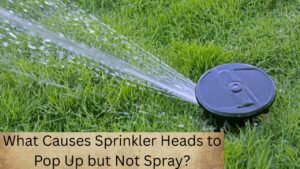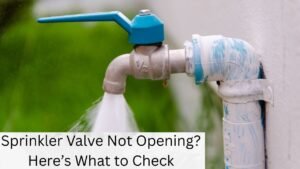Underground sprinkler leaks are sneaky. They waste water silently and raise your utility bill before you ever notice the soggy patch in your yard. But here’s the good news: you don’t have to dig up your whole lawn to find the problem.
With a sharp eye, the right tools, and a bit of irrigation knowledge, you can track down leaks fast — without a shovel.
Let’s walk through the full process of leak detection like a seasoned irrigation tech would. No fluff, no guesswork — just proven steps that save time, money, and your landscape.

Why Finding Underground Leaks Matters
Every drop of water leaking underground costs you money. It can also damage root systems, invite pests, and even trigger mold or mildew under your lawn.
Worse, leaks often lead to flooded valve boxes that short out components or block pressure entirely.
They also drop water pressure in specific zones, mess up spray patterns, and sometimes stop entire zones from working.
Even small leaks cause big problems if ignored.
Early Signs of a Hidden Leak
Before you grab tools or call a pro, learn to recognize the signs of an underground sprinkler leak:
- Unusually high water bills with no change in usage
- Wet spots in the lawn that don’t dry out
- Mushy or sunken areas in the soil
- Sprinkler heads that sputter, pop up weakly, or don’t spray at all
- Low water pressure in one zone
- Air bubbles or hissing sounds when a zone is running
Seeing just one of these doesn’t confirm a leak. But if you spot two or more, there’s likely a break somewhere below ground.
Tools That Help Find Leaks Without Digging
You don’t need to tear up your entire yard. These simple tools can help you pinpoint a leak’s location:
- Irrigation pressure gauge: Measures zone pressure to detect inconsistencies
- Soil moisture meter: Identifies oversaturated areas
- Acoustic leak detector: Listens for sound signatures of leaks underground
- Infrared thermometer or thermal camera: Shows cooler zones from wet soil
- Flag markers: Helps track visual clues zone by zone
- Stopwatch and water meter: Used together to run a pressure-loss test
If you don’t own these, some irrigation companies offer inspections using this equipment without needing to dig.
Step-by-Step: How to Detect a Leak Below the Surface
Let’s break down a proven method to find underground leaks using no invasive work. Follow this order for best results:
Step 1: Check Your Water Meter
Start by shutting off all water in the house. Then, go outside and look at your water meter.
- Take note of the reading
- Wait 15 to 30 minutes
- If the meter dial moves, water is running — and if everything’s off inside, it’s likely an irrigation leak
This gives you a quick answer: yes or no on whether you have a leak.
Step 2: Run a Manual Test by Zone
Next, turn on each sprinkler zone one at a time from your controller. Watch how the heads behave.
You’re looking for:
- Delayed or incomplete pop-up
- Air bubbles escaping from the ground
- Pools forming around a certain area
- Pressure drops in one zone only
If only one zone has symptoms, the leak is likely between the valve and that group of heads.
Step 3: Use a Moisture Meter or Infrared Thermometer
Run your suspicious zone for a few minutes, then turn it off.
Grab a moisture meter or infrared thermometer and walk the zone grid-style.
- Moisture meter: press into the soil and watch for unusual spikes
- Infrared: look for cooler, wetter ground that stays damp longer
Use flags to mark suspicious spots as you go. Leaks often form 12–18 inches away from the sprinkler head, especially around fittings.
Step 4: Perform a Pressure Drop Test
Still unsure? Do a pressure drop test:
- Attach a pressure gauge to a test bib or hose port
- Run the zone for 5–10 minutes
- Watch for a sudden drop below normal PSI (usually under 30 PSI indicates a leak)
Compare this to a healthy zone for reference. If your PSI is way lower and you’re seeing wet ground, that confirms an underground break.
Hidden Leak Locations to Check
Even if you can’t see the pipe, you can still narrow down leak-prone areas:
- Around fittings or elbows (where two pipes meet)
- Near sprinkler heads (especially if they wiggle when touched)
- Just downstream from valves (where pressure builds)
- In low points of the yard (where water naturally collects)
- Where tree roots cross your line (roots often crack PVC or kink poly)
Knowing where these issues typically occur helps you avoid guesswork.
When to Call a Professional Leak Locator
If you’ve marked a zone but can’t pinpoint the break, a professional leak detection service can help.
They use advanced tools like:
- Ultrasonic listening devices
- Thermal imaging cameras
- Ground-penetrating radar
- Line locators that track buried PVC and poly piping
Hiring a pro costs $100–$300 depending on your region and system layout. But it’s often cheaper than replacing landscaping from blind digging.
How to Prevent Underground Leaks in the Future
Most leaks start small. Here’s how to stop them before they grow:
- Winterize your system if you live in a freeze zone
- Use flex risers that can bend instead of crack under pressure
- Avoid running heavy equipment over your lawn
- Don’t let tree roots grow near sprinkler lines
- Do seasonal system checks in spring and fall
- Upgrade to pressure-regulated heads to reduce water hammer stress
And if something does break? Be ready. Here’s a full breakdown of how much sprinkler repairs typically cost — and what can make them cheaper or more expensive.
Final Thoughts From a Seasoned Irrigation Pro
Finding an underground sprinkler leak without digging isn’t just possible — it’s practical. With a careful eye and the right tools, you can track leaks with accuracy, protect your lawn, and avoid unnecessary trenching.
If you notice uneven watering, high bills, or soggy spots, don’t ignore them. The sooner you catch a leak, the less it’ll cost to fix.
Need help reading pressure numbers, understanding thermal results, or choosing the right moisture meter? There’s a ton of smart, affordable leak detection gear out there that can do the job — and I’ve tested nearly all of it.
If you’re ready to stop guessing and start detecting, this is the best time to check your system before summer hits.




